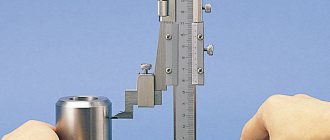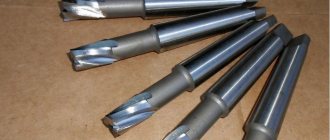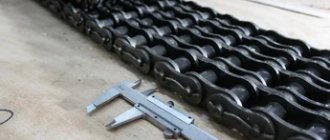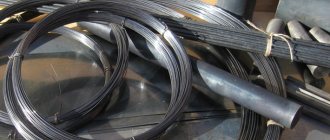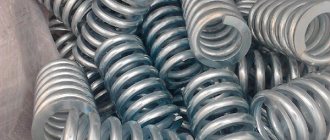Vernier caliper device
Its movable frame consists of two parts - the actual frame 3 with a sponge and an additional slider 6, with the help of which the caliper is accurately installed. Having loosened screws 1 and 2 securing the movable frame and slider on the caliper rod, roughly set the caliper to the required size; frame 3 and slider 6 move together.
Then slider 6 is secured with screw 2 and using micrometric screw 4, rotating knurled nut 5, accurately install the caliper. Having secured screw 1, read the resulting size.
Details
What to look for when choosing
Materials
What types of calipers exist based on materials of manufacture? Metal calipers are usually made from stainless and carbon steel, as well as from low-alloy tool steels KhVG and 9ХС. Stainless steel tools are classics, but in the production of modern calipers, composites are also used, for example, based on carbon fiber and polymer resin.
Dimensions
Typical dimensions of a classic caliper:
- Sponge size for external measurements is from 3.5 to 30 cm.
- The size of the sponge for taking internal measurements is from 0.6 to 2.2 cm.
- Measuring range up to 200 cm.
- Vernier size is from 0.9 to 3.9 cm.
- Weight (will depend on size and material) from 0.2 to 8.9 kg.
Models with a measurement range of up to 5 meters can weigh more than 35 kg.
GOST
These current GOSTs regulate both the inspection and production of tools (calipers):
- GOST 8.113-85 - helps determine the inspection procedure.
- GOST 166-89 - helps determine technical conditions.
Now a little about accuracy.
Accuracy
Vernier-type calipers are characterized by several accuracy classes:
- First class - in it the error will be 0.005 cm (a twentieth of a millimeter).
- Second class - the error will be 0.01 cm (tenth of a millimeter).
For high-frequency measurements, a completely different instrument is used, called a micrometer. To clearly show what the accuracy class will influence, it is enough to assume that the diameter of certain drills should be determined without markings. A caliper of the second accuracy class will make it possible to select drills with a diameter of 0.67 and 0.68 cm, and of the first class and 0.675 cm. For electronic type tools, the error can be 0.001 cm.
Verification
In the process of performing work with a caliper, a violation of the settings, various deformations of individual elements and simple wear may be visible. All this will affect the accuracy of the measurements, which can be distorted by adhering dirt, grease, and metal filings that cover the instrument with a magnetized layer.
Please note that every owner of a caliper needs to handle the tool with care and keep the tool clean.
To avoid various distortions in the measurement results, the instrument should be checked every year. To do this, it will be enough to contact a special service center for repair and setup. Based on the verification results, a special certificate is issued. At home, you can perform a simple check of the correctness of the readings if you press the jaws of the bar all the way. In this case, the zero strokes must necessarily coincide. Let's look at other types of calipers.
Marking
There are these types of markings:
- ШЦ-1 – makes it possible to determine the internal and external dimensions due to two pairs of jaws. The depth of the holes will be determined using an appropriate ruler.
- ШЦ-IC - readings will be simplified due to the arrow head, and its gears will be engaged with a rack that is installed in the rods.
- ShTsT-I – one-sided jaws have a hard alloy coating. All are used in highly abrasive conditions.
- ШЦК - used where high measurement accuracy is not needed, because readings are taken from a circular scale, and it is based on a spring mechanism.
- ШЦ-II – a frame feeding mechanism has been added to the double-sided jaws, and this allows marking.
- ШЦ-III – a characteristic feature is one-sided jaws, as well as large sizes. It cannot measure depth.
- ШЦЦ – readings are taken using a digital scale.
Next, let's take a closer look at the types of calipers.
Types of calipers and cost
Calipers can be divided into the following main types.
Analog
The counting can be carried out by a vernier, and its other name is “vernier”. Cost from 450 rubles.
Switch
No calculations required, easier to use because the measurement results will be displayed on the dial with a circular scale. Cost from 1800 rubles.
Digital
With a small display, and digital measurements are displayed on it. Has high accuracy. Another name would be electronic. Cost from 780 rubles for the simplest models. Moreover, the booms can be with a depth gauge (type T-I or I) or without it (type II and III).
Precision calipers are a general name for models that have an increased level of measurement accuracy. By the way, if a monoblock instrument (fixed lips are not attached to the bar, but are an integral part of it) is capable of giving the most accurate readings. There are tasks for which a standard tool simply cannot cope.
Special calipers
There are striking examples of special models.
Marking
With carbide sharpened jaws and a special compass mechanism. In addition to taking measurements, it is possible to draw arcs on the carbide material using the jaws themselves. A caliper for marking will be similar to options without a compass-type mechanism with jaws based on hard alloys. Cost from 2600 rubles.
ШЦЦД (for brake discs)
The types of calipers and their purposes differ from each other. Designs with elongated one-sided jaws for external measurements, which have teeth on the working surface to improve measurement accuracy. There are options that allow you to determine the thickness of car brakes and discs without having to remove the wheels. The cost of the simplest week is approximately 1,000 rubles.
Traveler
It is suitable for measuring rail tracks. The cost of the tool is from 20,000 rubles. By the way, analogues of calipers include the following measuring instruments, which are described below.
Vernier gauge
This tool is needed to measure the teeth of racks and gears with an accuracy of 0.002 cm.
Vernier depth gauge
Such a tool is needed to measure the depth, height of a blind hole, protrusions, and grooves.
Shtangenreysmas
This tool allows you to measure heights without special skills and perform vertical markings of parts with an accuracy of 0.005 cm.
Vernier has 20 divisions
The vernier of the caliper in question has 20 divisions, each of which is taken as five when counting. Therefore, the number 25 is marked on the vernier against the 5th line, the number 50 against the 10th, etc. Thus, the 1st line of the vernier gives the 5th division, the 4th - the 20th, the 1st after 25 th - 30th division, etc.
All 20 divisions of the vernier are equal to 39 divisions of the rod, i.e. 39 mm, so each division is equal to 1.95 mm. As a result, no two or more strokes of the vernier can simultaneously coincide with the strokes of the rod scale. The exception is the zero and very last strokes of the vernier, which simultaneously coincide with the strokes of the rod scale.
The reading of the caliper with this position of the vernier is measured only by the zero stroke, but not by the last one. At the moment when the 1st stroke of the vernier (after the zero) exactly coincides with the 2nd stroke of the rod scale, the distance between the measuring surfaces of the caliper legs will be 2 - 1.95 = 0.05 mm.
If the 2nd stroke of the vernier coincides with the stroke of the rod, the caliper reading is 4 - 2 x 1.95 = 4 - 3.9 = 0.1 mm. If the frame is moved a little more so that the 3rd stroke of the vernier coincides with the stroke of the rod, the distance between the measuring surfaces will be 0.15 mm.
Thus, the coincidence of each subsequent stroke adds 0.05 mm, which is a multiple of the designations on the vernier scale. The coincidence of the zero line of the vernier with the 1st line of the rod scale corresponds to the distance between the measuring surfaces of the jaws equal to 1 mm, with the 10th line - a distance of 10 mm, etc.
General information
Operating principle and purpose
The purpose of a caliper is to take high-precision measurements of the outside and inside of the objects being measured, as well as the depths of various holes. A special feature of the tool is its versatility. The common name for this tool is “shtangel” among those who constantly use it, and is the simplest abbreviation of the word.
Such a tool “can” measure the internal and external diameters of cylindrical and round objects, for example, nuts and bolts, and is suitable for internal measurements of grooves according to the required parameters. The principle of measuring with a caliper will be to determine the size based on the position of the measurement frame, which moves freely along the rod with a scale that is printed. The value itself will be determined by the coincidence method, and the accuracy, depending on the accuracy class, will reach hundredths of millimeters.
Device, properties and characteristics
If you use your imagination, you will notice that in appearance the caliper looks like a symbiosis of a ruler and a hammer. A classic instrument consists of the following elements:
A rod with a marked scale, and the maximum measurement value will depend on the length of the rod.- Measuring frame - we are talking about a movable part of the bar that can move along the bar. It is marked with a vernier scale, which makes it possible to determine millimeter fractions. A spring with a screw for fixation is installed inside the frame, which presses it against the rod, and this reduces the measurement error, which can increase due to the skew of the moving part relative to the stationary part. Instead of a vernier, a dial scale or a small digital display may be installed, and this will depend on the caliper model.
- Fixed jaw - structurally it is part of the rod or rigidly attached to it, and is located on one side of the tool. The working area is the inner edge of a stationary type sponge, and when taking measurements it must be firmly applied to the object being measured.
- The movable jaw is a structural part of the frame or is rigidly fixed to it. The working part is also internal, and the part is located exactly opposite the fixed jaw so that when the frame is moved, the edges of the two jaws touch. In this position, the zero parameters of the rod and vernier scales must coincide.
- The retractable bar is part of a structural type measuring frame and its purpose is to measure depth in an object.
The design discussed above has one-sided jaws, which makes it possible to determine only the external dimensions of objects. For internal measurements, you need a caliper with jaws on both sides. The second ones usually have smaller dimensions, which are located similarly, but on the opposite side of the bar, and the working edges will be the outer edges.
Main types of calipers:
TYPE I - double-sided with depth gauge (Fig. 1);
TYPE T-1 - single-sided with a depth gauge with measuring surfaces made of hard alloys (Fig. 2);
TYPE II - double-sided (Fig. 3);
schts 250
TYPE III - one-sided (Fig. 4);
How to choose a good tool
The main advantages of a caliper are the accuracy of measurements. For this reason, a high-quality tool must be made of durable material, have easily visible markings and withstand heavy use. Stainless steel tools with engraved markings are popular among experienced craftsmen due to their high resistance to durability and corrosion.
The main principles of choice will be the following:
- Length - it will determine the measurement range. It should be selected depending on the tasks. For everyday use, a tool measuring 12.5 cm will be sufficient, but for building a house, for example, you will need a boom 5 meters long.
- Measurement step - roughly speaking, the measurement result will be much more accurate for those models that have the smallest distance between adjacent scale divisions.
- Price – you shouldn’t buy an expensive model for occasional home use, but a good caliper won’t come cheap. Craftsmen for whom this instrument is the main one for measurements should look towards proven German, Japanese and Swiss models. High-quality tools, especially electronic ones, are very expensive, and it is enough to buy them once, because they will last a lifetime. The frequency of use should be based on the price of the tool.
Before purchasing a bar, make sure that there are no gaps between the fixed and moving parts, and that the zero marks of both scales match when the jaws are closed.
